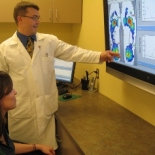Podiatrist Dr. DeBrule uses F-Scan in Practice
See how one podiatrist uses the F-Scan to benefit his practice! Michael DeBrule, DPM, states, “the number of orthotics I prescribe per week has easily doubled, and my patients have better clinical outcomes.”
The F-Scan Leads to Better Treatment Outcomes in Podiatry Practice
Michael DeBrule, DPMMarshall, MN
A light bulb moment comes when you suddenly realize something of great importance. Cue up a mental image of a purple cartoon cat with a light bulb above his head who suddenly realizes how to catch a mouse.
My light bulb moment came in 2006 at the Professional Foot and Orthotic Lab Association (PFOLA) conference in Vancouver. I was listening to a lecture about something called the F-Scan™ plantar pressure analysis system for in-shoe pressure analysis and the light bulb thing happened to me. I knew I had stumbled onto something that would really improve my podiatry practice. When I came back from Vancouver I thought to myself, don’t my patients here in small town Marshall, Minnesota deserve the best that technology has to offer? So, I researched other pressure analysis systems, and the F-Scan clearly seemed to be the best system for my podiatry practice. Six months later, with an ear-to-ear grin, I was opening up the box with the new F-Scan system just like a little kid on Christmas.
I unpacked the machine and tried to hook it up and figure things out. However, I didn’t really know how this crazy thing worked. Fortunately, Tekscan sent out trainer Jay Cohen to educate me and my staff on the system. Jay was excellent and very thorough. I treated him to some local grub at the Wooden Nickel Bar and he talked about how Marshall seemed so remote compared to New Jersey where he is from. I have to admit, there are a lot more corn fields here in southwest Minnesota.
Of course my training didn’t end after Jay’s visit (physicians are always learning). One month after Jay visited my office, I attended an F-Scan seminar in Cleveland. Dr. Norman Murphy gave an excellent overview of how to use the F-Scan and interpret the results clinically. I also have attended Dr. Murphy’s webinars online through Tekscan. Last September, I went to New York to consult with the well-known biomechanics expert, and fellow F-Scan user, Dr. George Trachtenberg.
Now, in everyday English, what is the F-Scan? Well, it is kind of like doing an EKG test, but for the foot. Paper-thin insole sensors are placed inside a patient’s shoe. Each sensor is similar to having over 900 tiny little scales in the patient’s shoe. When a patient walks, runs, or stands, the sensors send information back to the computer about pressure distribution, force, and timing.
This information has useful clinical applications:
- Plantar pressure and gait analysis for sports applications such as running, soccer, baseball, basketball, walking, hockey, football, skiing, and golf
- Identifying and preventing areas of potential ulceration (sores)
- Monitoring degenerative foot disorders
- Observing gait abnormalities
- Immediately determining the efficiency of orthotic arch support
- Pre- and post-surgical evaluations
- Troubleshooting for orthotic and treatment plan failures
Looking back, F-Scan has been great for my practice and my patients. The number of orthotics I prescribe per week has easily doubled and my patients have better clinical outcomes. Last month I moved into a brand new office, twice the size of my old one. My new office features a 450 square foot gait room with a walkway for the F-Scan and video gait analysis. The F-Scan has also opened a door to helping new patients with postural pain (lower back, hip, and knee pain) by correcting their foot dysfunction. It’s nice to start my Monday morning with hearing how someone’s lower back pain is improving along with their forefoot pain. Postural pain patients are starting to trickle into my office by word of mouth even when they don’t have any foot pain.
What happens when patients don’t get better and the pain doesn’t go away? Instead of just shrugging my shoulders, I retest with the F-Scan. Then I try to change whatever I missed in my orthotic prescription or treatment plan.
Now the F-Scan is only a diagnostic test, like an MRI or a white blood count. Ordering a test does not guarantee that a patient’s condition will get better or improve. But why would you walk in the dark if you could turn on a light bulb?
